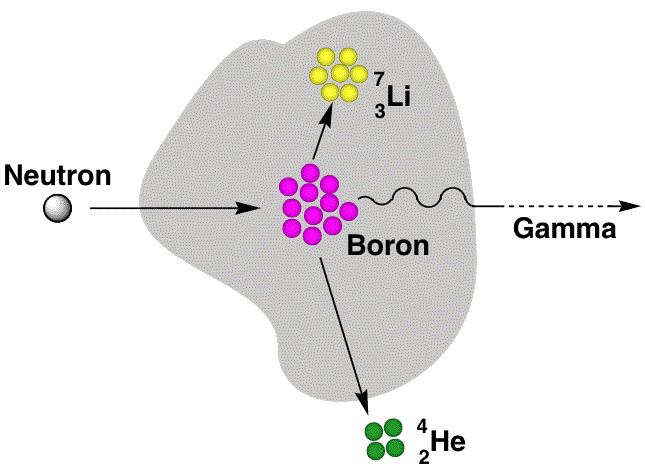 | ||
Neutron capture therapy (NCT) is a noninvasive therapeutic modality for treating locally invasive malignant tumors such as primary brain tumors and recurrent head and neck cancer. Briefly summarized, it is a two step procedure: first, the patient is injected with a tumor localizing drug containing the non-radioactive isotope boron-10 (10B) that has a high propensity or cross section (σ) to capture slow neutrons. The cross section of the 10B is many times greater than that of the other elements present in tissues such as hydrogen, oxygen, and nitrogen. In the second step, the patient is radiated with epithermal neutrons, the source of which is either a nuclear reactor or, more recently, an accelerator. After losing energy as they penetrate tissue, the neutrons are absorbed by the capture agent, which subsequently emits high-energy charged particles that can selectively kill tumor cells that have taken up sufficient quantities of 10B (Fig.1).
Contents
- History
- Basic principles
- Radiobiological considerations
- Clinical dosimetry
- Boron delivery agents
- Gadolinium neutron capture therapy Gd NCT
- Early studies in the US and Japan
- More recent clinical studies in the US and Japan
- Clinical studies in Finland
- Clinical studies in Sweden
- Head and neck cancers
- Melanoma
- Colorectal cancer
- Conclusions
- References
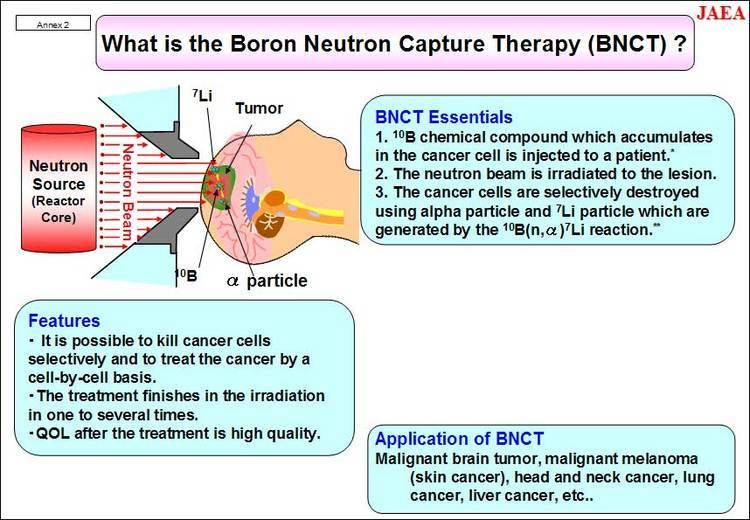
All of the clinical experience to date with NCT is with the non-radioactive isotope boron-10, and this is known as boron neutron capture therapy (BNCT). At this time, the use of other non-radioactive isotopes, such as gadolinium, has been limited, and to date, it has not been used clinically. BNCT has been evaluated clinically as an alternative to conventional radiation therapy for the treatment of malignant brain tumors (gliomas), and recurrent, locally advanced head and neck cancer.

History
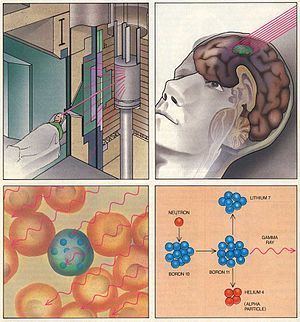
After the initial discovery of the neutron in 1932 by Sir James Chadwick, H. J. Taylor in 1935 showed that boron-10 nuclei had a propensity to capture thermal neutrons. This resulted in nuclear fission of the boron-11 nuclei into helium-4 (alpha particles) and lithium-7 ions. In 1936, G.L. Locher, a scientist at the Franklin Institute in Pennsylvania, recognized the therapeutic potential of this discovery and suggested that neutron capture could be used to treat cancer. W. H. Sweet, from Massachusetts General Hospital, first suggested the technique for treating malignant brain tumors and a trial of BNCT against the most malignant of all brain tumors, glioblastoma multiforme, using borax as the delivery agent in 1951. A clinical trial was initiated in a collaboration with Brookhaven National Laboratory in Long Island, U.S.A. and the Massachusetts General Hospital in Boston in 1954.
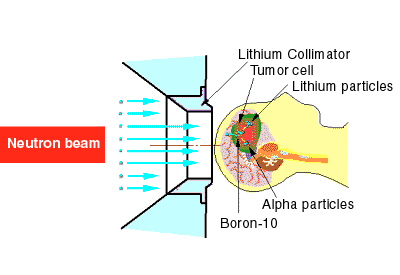
In the past 25 years a number of research groups throughout the world have continued the early groundbreaking work of William Sweet and Ralph Fairchild, and in particular, the pioneering clinical studies of Hiroshi Hatanaka in Japan. This was followed by clinical trials in a number of other countries including the United States, Sweden, Finland, Czech Republic, Argentina, European Union (centered in the Netherlands) and Japan. Currently, the program in Japan has transitioned from a reactor neutron source to accelerators, and now a Phase I trial is underway to evaluate the safety of the accelerator neutron sources.
Basic principles

Neutron capture therapy is a binary system that uses two separate components to achieve a therapeutic effect. Each component in itself is non-tumoricidal, but when combined together they are highly lethal to cancer cells.
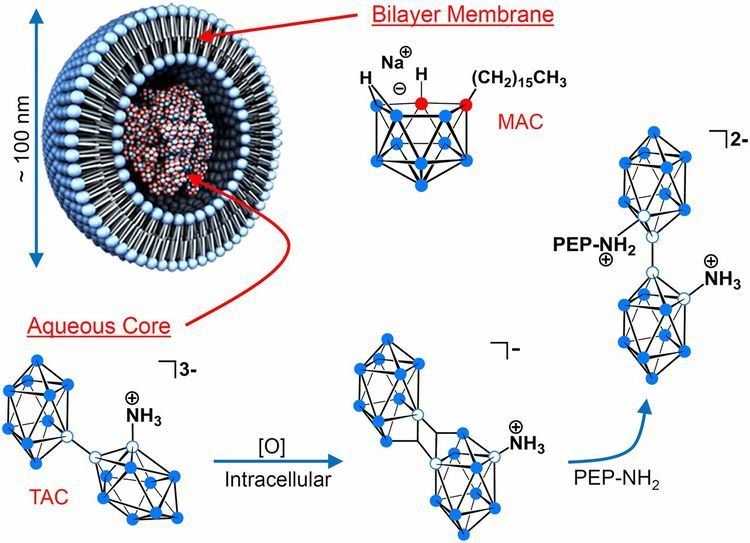
BNCT is based on the nuclear capture and fission reactions that occur when non-radioactive boron-10, which makes up approximately 20% of natural elemental boron, is irradiated with neutrons of the appropriate energy to yield excited boron-11 (11B*), which undergoes instantaneous nuclear fission to produce high energy alpha particles (4He nuclei) and high energy lithium-7 (7Li) nuclei. The nuclear reaction is:
10B + nth → [11B] *→ α + 7Li + 2.31 MeVBoth the alpha particles and the lithium ions produce closely spaced ionizations in the immediate vicinity of the reaction, with a range of 5–9 µm, which is approximately the diameter of the target cell. The lethality of the capture reaction is limited to boron containing cells. BNCT, therefore, can be regarded as both a biologically and a physically targeted type of radiation therapy. The success of BNCT is dependent upon the selective delivery of sufficient amounts of 10B to the tumor with only small amounts localized in the surrounding normal tissues. Thus, normal tissues, if they have not taken up sufficient amounts of boron-10, can be spared from the nuclear capture and fission reactions. Normal tissue tolerance is determined by the nuclear capture reactions that occur with normal tissue hydrogen and nitrogen.
A wide variety of boron delivery agents have been synthesized, but only two of these currently are being used in clinical trials. The first, which has been used primarily in Japan, is a polyhedral borane anion, sodium borocaptate or BSH (Na2B12H11SH), and the second is a dihydroxyboryl derivative of phenylalanine, referred to as boronophenylalanine or BPA. The latter has been used in clinical trials in the United States, Finland, Japan and more recently, Argentina and Taiwan. Following administration of either BPA or BSH by intravenous infusion, the tumor site is irradiated with neutrons, the source of which up until now has been specially designed nuclear reactors. Until 1994, low-energy (< 0.5 eV) thermal neutron beams were used in Japan and the United States, but since they have a limited depth of penetration in tissues, higher energy (>.5eV<10 keV) epithermal neutron beams, which have a greater depth of penetration, have been used in clinical trials in the United States, Europe, Japan, Argentina, Taiwan, and China. In theory BNCT is a highly selective type of radiation therapy that can target tumor cells without causing radiation damage to the adjacent normal cells and tissues. Doses up to 60–70 grays can be delivered to the tumor cells in one or two applications compared to 6–7 weeks for conventional fractionated external beam photon irradiation. However, the effectiveness of BNCT is dependent upon a relatively homogeneous cellular distribution of 10B within the tumor, and this is still one of the main unsolved problems that have limited its success.
Radiobiological considerations
The radiation doses delivered to tumor and normal tissues during BNCT are due to energy deposition from three types of directly ionizing radiation that differ in their linear energy transfer (LET), which is the rate of energy loss along the path of an ionizing particle:
1. low LET gamma rays, resulting primarily from the capture of thermal neutrons by normal tissue hydrogen atoms [1H(n,γ)2H];
2. high LET protons, produced by the scattering of fast neutrons and from the capture of thermal neutrons by nitrogen atoms [14N(n,p)14C]; and
3. high LET, heavier charged alpha particles (stripped down helium [4He] nuclei) and lithium-7 ions, released as products of the thermal neutron capture and fission reactions with 10B [10B(n,α)7Li].
Since both tumor and surrounding normal tissues are present in the radiation field, even with an ideal epithermal neutron beam, there will be an unavoidable, nonspecific background dose, consisting of both high and low LET radiation. However, a higher concentration of 10B in the tumor will result in it receiving a higher total dose than that of adjacent normal tissues, which is the basis for the therapeutic gain in BNCT. The total radiation dose in Gy delivered to any tissue can be expressed in photon-equivalent units as the sum of each of the high LET dose components multiplied by weighting factors (Gyw), which depend on the increased radiobiological effectiveness of each of these components.
Clinical dosimetry
Biological weighting factors have been used in all of the recent clinical trials in patients with high grade gliomas, using boronophenylalanine (BPA) in combination with an epithermal neutron beam. The 10B(n,α)7Li component of the radiation dose to the scalp has been based on the measured boron concentration in the blood at the time of BNCT, assuming a blood: scalp boron concentration ratio of 1.5:1 and a compound biological effectiveness (CBE) factor for BPA in skin of 2.5. A relative biological effectiveness (RBE) factor of 3.2 has been used in all tissues for the high LET components of the beam, such as alpha particles. The RBE factor is used to compare the biologic effectiveness of different types of ionizing radiation. The high LET components include protons resulting from the capture reaction with normal tissue nitrogen, and recoil protons resulting from the collision of fast neutrons with hydrogen. It must be emphasized that the tissue distribution of the boron delivery agent in humans should be similar to that in the experimental animal model in order to use the experimentally derived values for estimation of the radiation doses for clinical radiations. For more detailed information relating to computational dosimetry and treatment planning, interested readers are referred to a comprehensive review on this subject.
Boron delivery agents
The development of boron delivery agents for BNCT began approximately 50 years ago and is an ongoing and difficult task of high priority. A number of boron-10 containing delivery agents have been prepared for potential use in BNCT. The most important requirements for a successful boron delivery agent are:
However, it should be noted that at this time no single boron delivery agent fulfills all of these criteria. With the development of new chemical synthetic techniques and increased knowledge of the biological and biochemical requirements needed for an effective agent and their modes of delivery, a number of promising new boron agents has emerged (see examples in Table 1).
*These are the only two boron delivery agents that have been used clinically.
The major challenge in the development of boron delivery agents has been the requirement for selective tumor targeting in order to achieve boron concentrations sufficient to produce therapeutic doses of radiation at the site of the tumor with minimal radiation delivered to normal tissues. The selective destruction of brain tumor (glioma) cells in the presence of normal cells represents an even greater challenge compared to malignancies at other sites in the body, since malignant gliomas are highly infiltrative of normal brain, histologically diverse and heterogeneous in their genomic profile. In principle, NCT is a radiation therapy that could selectively deliver lethal doses of radiation to tumor cells while sparing adjacent normal cells.
Gadolinium neutron capture therapy (Gd NCT)
There also has been interest in the possible use of gadolinium-157 (157Gd) as a capture agent for NCT for the following reasons: First, and foremost, has been its very high neutron capture cross section of 254,000 barns. Second, gadolinium compounds, such as Gd-DTPA (gadopentetate dimeglumine Magnevist®), have been used routinely as contrast agents for magnetic resonance imaging (MRI) of brain tumors and have shown high uptake by brain tumor cells in tissue culture (in vitro). Third, gamma rays and internal conversion and Auger electrons are products of the 157Gd (n,γ)158Gd capture reaction (157Gd + nth (0.025eV) → [158Gd] → 158Gd + γ + 7.94 MeV). Although the gamma rays have long pathlengths, orders of magnitude greater depths of penetration compared with the other radiations, the other radiation products (internal conversion and Auger electrons) have pathlengths of approximately one cell diameter and can directly damage DNA. Therefore, it would be highly advantageous for the production of DNA damage if the 157Gd were localized within the cell nucleus. However, the possibility of incorporating gadolinium into biologically active molecules is very limited and only a small number of potential delivery agents for Gd NCT have been studied. Relatively few studies with Gd have been carried out in experimental animals compared to the large number with boron containing compounds (Table 1), which have been synthesized and evaluated in experimental animals (in vivo). Although in vitro activity has been demonstrated using the Gd-containing MRI contrast agent Magnevist® as the Gd delivery agent, there are very few studies demonstrating the efficacy of Gd NCT in experimental animal tumor models, and Gd NCT has to date never been used clinically (i.e., in humans).
Early studies in the US and Japan
It was not until the 1950s that the first clinical trials were initiated by Farr at the Brookhaven National Laboratory (BNL) in New York and by Sweet and Brownell at the Massachusetts General Hospital (MGH) using the Massachusetts Institute of Technology (MIT) nuclear reactor (MITR) and several different low molecular weight boron compounds as the boron delivery agent. However, the results of these studies were disappointing, and no further clinical trials were carried out in the United States until the 1990s.
Following a two-year fellowship in Sweet's laboratory, clinical studies were initiated by Hiroshi Hatanaka in Japan in 1967. He used a low energy thermal neutron beam, which had low tissue penetrating properties, and sodium borocaptate (BSH) as the boron delivery agent. Initially, this had been developed as a boron delivery agent by Albert Soloway at the MGH. In Hatanaka's procedure, as much as possible of the tumor was surgically resected ("debulking"), and at some time thereafter, BSH was administered by a slow infusion, usually intra-arterially, but later intravenously. Twelve to 14 hours later, BNCT was carried out at one or another of several different nuclear reactors using low energy thermal neutron beams. The less tissue-penetrating properties of the thermal neutron beams necessitated reflecting the skin and raising a bone flap in order to directly irradiate the exposed brain, a procedure first used by Sweet and his collaborators.
Approximately 200+ patients were treated by Hatanaka, and subsequently by his associate, Nakagawa. Due to the heterogeneity of the patient population, in terms of the microscopic diagnosis of the tumor and its grade, size, and the ability of the patients to carry out normal daily activities (Karnofsky performance status), it was not possible to come up with definitive conclusions about therapeutic efficacy. However, the survival data were no worse than those obtained by standard therapy at the time, and there were several patients who were long-term survivors, and most probably they were cured of their brain tumors.
More recent clinical studies in the US and Japan
BNCT of patients with brain tumors was resumed in the United States in the mid-1990s by Chanana, Diaz, and Coderre and their co-workers at the Brookhaven National Laboratory Medical Research Reactor (BMRR) and at Harvard/Massachusetts Institute of Technology (MIT) using the MIT Research Reactor (MITR). For the first time, BPA was used as the boron delivery agent, and patients were irradiated with a collimated beam of higher energy epithermal neutrons, which had greater tissue-penetrating properties than thermal neutrons. A research group headed up by Zamenhof at the Beth Israel Deaconess Medical Center/Harvard Medical School and MIT was the first to use an epithermal neutron beam for clinical trials. Initially patients with cutaneous melanomas were treated and this was expanded to include patients with brain tumors, specifically melanoma metastatic to the brain and primary glioblastomas (GBMs). Included in the research team were Otto Harling at MIT and the Radiation Oncologist Paul Busse at the Beth Israel Deaconess Medical Center in Boston. A total of 22 patients were treated by the Harvard-MIT research group. Five patients with cutaneous melanomas were treated using an epithermal neutron beam at the MIT research reactor (MITR-II) and subsequently patients with brain tumors were treated using a redesigned beam at the MIT reactor which possessed far superior characteristics to the original MITR-II beam, and BPA as the capture agent. The clinical outcome of the cases treated at Harvard-MIT has been summarized by Busse. Although the treatment was well tolerated, there were no significant differences in the mean survival times of patients that had received BNCT compared to those who received conventional external beam X-irradiation.
Miyatake and Kawabata at Osaka Medical College in Japan have carried out extensive clinical studies employing the combination of BPA (500 mg/kg) and BSH (100 mg/kg), infused intravenously (i.v.) over 2 h, followed by neutron irradiation at Kyoto University Research Reactor Institute (KURRI). The Mean Survival Time (MST) of 10 patients in the first of their trials was 15.6 months, with one long-term survivor (>5 years). Based on experimental animal data, which showed that BNCT in combination with X-irradiation produced enhanced survival compared to BNCT alone, Miyatake and Kawabata combined BNCT, as described above, with an X-ray boost. A total dose of 20 to 30 Gy was administered, divided into 2 Gy daily fractions. The MST of this group of patients was 23.5 months and no significant toxicity was observed, other than hair loss (alopecia). However, a significant subset of these patients developed cerebrospinal fluid dissemination of their tumors. In another Japanese trial, carried out by Yamamoto et al., BPA and BSH were infused over 1 h, followed by BNCT at the Japan Research Reactor (JRR)-4 reactor. Patients subsequently received an X-ray boost after completion of BNCT. The overall median survival time (MeST) was 27.1 months, and the 1 year and 2-year survival rates were 87.5 and 62.5%, respectively. Based on the reports of Miyatake, Kawabata, and Yamamoto, it appears that combining BNCT with an X-ray boost can produce a significant therapeutic gain. Further studies are needed to optimize this combined therapy and to evaluate it using a larger patient population.
Clinical studies in Finland
A team of clinicians led by Heikki Joensuu and Leana Kankaanranta and nuclear engineers led by Iro Auterinen at the Helsinki University Central Hospital and VTT Technical Research Center of Finland have treated approximately 200+ patients with recurrent malignant gliomas (glioblastomas) and head and neck cancer who had undergone standard therapy, recurred, and subsequently received BNCT at the time of their recurrence using BPA as the boron delivery agent. The median time to progression in patients with gliomas was 3 months, and the overall MeST was 7 months. It is difficult to compare these results with other reported results in patients with recurrent malignant gliomas, but they are a starting point for future studies using BNCT as salvage therapy in patients with recurrent tumors. Due to a variety of reasons including financial, no further studies have been carried out at this facility, which is scheduled for decommissioning.
Clinical studies in Sweden
Finally, to conclude this section, the following is a brief summary of a clinical trial that was carried out by Stenstam, Sköld, Capala and their co-workers in Sweden using BPA and an epithermal neutron beam at the Studsvik nuclear reactor, which had greater tissue penetration properties than the thermal beams originally used in Japan. This study differed significantly from all previous clinical trials in that the total amount of BPA administered was increased (900 mg/kg), and it was infused i.v. over 6 hours. This was based on experimental animal studies in glioma bearing rats demonstrating enhanced uptake of BPA by infiltrating tumor cells following a 6-hour infusion. The longer infusion time of the BPA was well tolerated by the 30 patients who were enrolled in this study. All were treated with 2 fields, and the average whole brain dose was 3.2–6.1 Gy (weighted), and the minimum dose to the tumor ranged from 15.4 to 54.3 Gy (w). There has been some disagreement among the Swedish investigators regarding the evaluation of the results. Based on incomplete survival data, the MeST was reported as 14.2 months and the time to tumor progression was 5.8 months. However, more careful examination of the complete survival data revealed that the MeST was 17.7 months compared to 15.5 months that has been reported for patients who received standard therapy of surgery, followed by radiotherapy (RT) and the drug temozolomide (TMZ). Furthermore, the frequency of adverse events was lower after BNCT (14%) than after radiation therapy (RT) alone (21%) and both of these were lower than those seen following RT in combination with TMZ. If this improved survival data, obtained using the higher dose of BPA and a 6-hour infusion time, can be confirmed by others, preferably in a randomized clinical trial, it could represent a significant step forward in BNCT of brain tumors, especially if combined with a photon boost.
Head and neck cancers
The single most important clinical advance over the past 13 years has been the application of BNCT to treat patients with recurrent tumors of the head and neck region who had failed all other therapy. These studies were first initiated by Kato et al. in Japan and subsequently followed by several other Japanese groups and by Kankaanranta, Joensuu, Auterinen and their co-workers in Finland. All of these studies employed BPA as the boron delivery agent, either alone or in combination with BSH. A very heterogeneous group of patients with a variety of histopathologic types of tumors have been treated, the largest number of which had recurrent squamous cell carcinomas. Kato et al. have reported on a series of 26 patients with far-advanced cancer for whom there were no further treatment options. Either BPA + BSH or BPA alone were administered by a 1 or 2 h i.v. infusion, and this was followed by BNCT using an epithermal beam. In this series, there were complete regressions in 12 cases, 10 partial regressions, and progression in 3 cases. The MST was 13.6 months, and the 6-year survival was 24%. Significant treatment related complications ("adverse" events) included brain necrosis, osteomyelitis, transient mucositis, and alopecia.
Kankaanranta et al. have reported their results in a prospective Phase I/II study of 30 patients with inoperable, locally recurrent squamous cell carcinomas of the head and neck region. Patients received either two or, in a few cases, one BNCT treatment using BPA (400 mg/kg), administered i.v. over 2 hours, followed by neutron irradiation. Of 29 evaluated patients, there were 13 complete and 9 partial remissions, with an overall response rate of 76%. The most common adverse event was oral mucositis, oral pain, and fatigue. Based on the clinical results, it was concluded that BNCT was effective for the treatment of inoperable, previously irradiated patients with head and neck cancer. Some responses were durable but progression was common, usually at the site of the previously recurrent tumor. As previously indicated in the section on neutron sources, all clinical studies have ended in Finland, based on a variety of reasons including economic difficulties of the two companies directly involved, VTT and Boneca. However, there are plans to resume clinical studies using an accelerator neutron source fabricated by Neutron Therapeutics, Danvers, Massachusetts. Finally, a group in Taiwan, led by Ling-Wei Wang and his co-workers at the Taipei Veterans General Hospital, have treated 17 patients with locally recurrent head and neck cancers at the Tsing Hua Open-pool Reactor (THOR) of the National Tsing Hua University. Two-year overall survival was 47% and two-year loco-regional control was 28%. Further studies are in progress to further optimize their treatment regimen.
Melanoma
Other extracranial tumors that have been treated include malignant melanomas, which originally was carried out in Japan by the late Yutaka Mishima and his clinical team in the Department of Dermatology at Kobe University using BPA and a thermal neutron beam. It is important to point out that it was Mishima who first used BPA as a boron delivery agent and this subsequently was extended to other types of tumors based on the experimental studies of Coderre et al. at the Brookhaven National Laboratory. Local control was achieved in almost all patients, and some were cured of their disease. More recently, Junichi Hiratsuka and his colleagues at Kawasaki Medical School Hospital have treated patients with melanoma of the head and neck region, vulva and vagina with impressive clinical results. The first clinical trial of BNCT in Argentina for the treatment of melanomas was performed in October 2003 and since then several patients with cutaneous melanomas have been treated as part of a Phase II clinical trial at the RA-6 nuclear reactor in Bariloche. The neutron beam has a mixed thermal-hyperthermal neutron spectrum that can be use to treat superficial tumors. Finally, as recently reported, the in-hospital neutron irradiator (IHNI) in Beijing has been used to treat the first patient, with a melanoma on the sole of his left foot, in August 2014. The patient had a complete clinical response with no evidence of late radiation injury during a 24-month follow-up period. The ultimate aim of the group in Beijing is to initiate a multi-institutional randomized clinical trial to evaluate BNCT of cutaneous melanomas.
Colorectal cancer
Two patients with colon cancer, which had spread to the liver, have been treated by Zonta and his co-workers at the University of Pavia in Italy. The first was treated in 2001 and the second in mid-2003. The patients received an i.v. infusion of BPA, followed by removal of the liver (hepatectomy), which was irradiated outside of the body (extracorporeal BNCT) and then re-transplanted into the patient. The first patient did remarkably well and survived for over 4 years after treatment, but the second died within a month of cardiac complications. Clearly, this is a very challenging approach for the treatment of hepatic metastases, and it is unlikely that it will ever be widely used. Nevertheless, the good clinical results in the first patient established proof of principle. Finally, Yanagie and his colleagues at Meiji Pharmaceutical University in Japan have treated several patients with recurrent rectal cancer using BNCT. Although no long-term results have been reported, there was evidence of short-term clinical responses.
Conclusions
BNCT represents a joining together of nuclear technology, chemistry, biology, and medicine to treat malignant gliomas and recurrent head and neck cancers. Sadly, the lack of progress in developing more effective treatments for these tumors has been part of the driving force that continues to propel research in this field. BNCT may be best suited as an adjunctive treatment, used in combination with other modalities, including surgery, chemotherapy, immunotherapy, and external beam radiation therapy for those malignancies, whether primary or recurrent, for which there are no effective therapies. Clinical studies have demonstrated the safety of BNCT. The challenge facing clinicians and researchers is how to move forward. A significant advantage of BNCT is the potential ability to selectively deliver a radiation dose to the tumor with a much lower dose to surrounding normal tissues. This is an important feature that makes BNCT particularly attractive for salvage therapy of patients with a variety of malignancies who already have been heavily irradiated. Although it may be only palliative, BNCT can produce striking clinical responses, as evidenced by the experiences of several groups treating patients with recurrent, therapeutically refractory head and neck cancers.
Problems with BNCT that need to be solved include:
- The development of more tumor-selective boron delivery agents for BNCT.
- Accurate, real time dosimetry to better estimate the radiation doses delivered to the tumor and normal tissues.
- Evaluation of recently constructed accelerator-based neutron sources as an alternative to nuclear reactors.
For a more detailed discussion of these problems and their solutions in BNCT, readers are referred to the published proceedings of the 16th and the abstracts of the 17th International Congresses on Neutron Capture Therapy and two reviews on the current status of BNCT of high grade gliomas and recurrent cancers of the head and neck region. If the problems enumerated above can be solved BNCT could have an important role in twenty-first century cancer treatment of those malignancies that are loco-regional and that are presently incurable by other therapeutic modalities.
